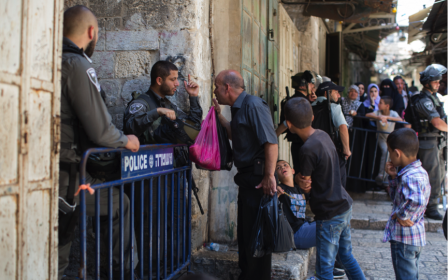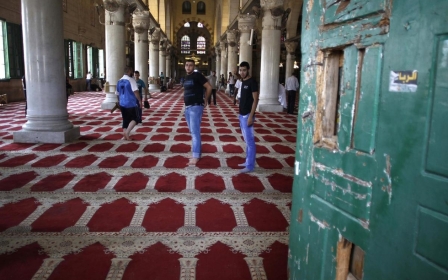BOOK REVIEW: 'Jerusalem Interrupted'

In compiling my own reference guide (palestinebooks.wordpress.com), I’m sometimes overwhelmed by the many titles on Palestinian history. Although Jerusalem isn’t ignored in them, we need to remember its importance. While it lacks the social exchange of port cities, it’s always been enriched by the influx of folks just keen to be there.
Surely Cairo and Damascus were the region’s biggest culture-generating power stations, but al-Quds was endowed with its own special urban flare, even before Lord Balfour signed on with the Zionists. A compendium of articles, Jerusalem Interrupted: Modernity and Colonial Transformation shines a light on some topics that have never had their own books in English. A smaller portion, chapters on the years of the Israeli state, leans far less on Arabic sources, but offers concise accounts nonetheless. So if you have intimate interests in art, music, fashion, archaeology, media, education, feminism, demography or health care, there’s something here for you in this curation of curiosities.
Europeans brought photography to Palestine in the mid-19th century but the first local lens guru was an Armenian patriarch named Garabedian, who was in touch with the leading Euro-techies and thus taught courses in the Old City. His main disciple started the first proper snappers’ studio, just by the Jaffa Gate, which was ideal for documenting intercity and village-to-city traffic, and of course the 1880s tourist trade.
It seems the first Palestinian-with-tripod was Khalil Raad, who even did family portraits of Edward Said’s clan. Sadly, his work and those of others wasn’t housed in such a good location. Not after 1948, when the neighbourhood became a border zone, and following the 1967 war, there was confiscation of such remaining archives. Family portraitures paid the rent, but the studio heads understood that they were also documentarians, selling works to National Geographic, the Illustrated London News, and even the Associated Press wire service. As for using the medium as fine art, there’s an early surrealist photomontage from 1922 of a Mr Skafi, three of him at the same table, dining on his very head.
In her contribution to Jerusalem Interrupted, Palestinian painter Samia Halaby shows that local Arab artists, until 1948, swopped influences with other practitioners in Haifa, Beirut, Damascus and also Europe. As the traditional religious customers were replaced by secular enthusiasts, some painters borrowed Islamic calligraphy’s flourish. Even the pen-and-inkers, who tended to be religious, infused their scripts with rhythmic embellishments, dressing up text in a kind of modern art ornamentation. Although Halaby’s written her own book on Palestinian fine art, her piece in the collection provides biographic profiles of her very favourites.
A survey of the music scene gallops with translation from rare Arabic sources, a privileged trotting through most of this book. In this case there’s no riding of RB Willson’s 2013 work, Orientalism and Musical Mission, proving that no one source has a lock on history. It’s another reminder that Jerusalem, on the edge of Greater Syria, was a major hub. Top talents such as the Egyptian oud ace and singer Muhammad Abd al-Wahhab were welcomed, and he would later record the poet Ali Mahmoud Taha’s own Nakba lament, "Falestine," in 1949. The YMCA music hall, seating 1,000 patrons, was second only to the Cairo Opera House. So we find a musical renaissance within earshot of the British, with quarter-tone Arabic scales and instruments inching towards western classical music.
Radio broadcasting started beaming in Jerusalem in 1936 and soon spread to Jenin and Jaffa. Radios were cheaper than gramophones, kept listeners up-to-date and didn’t require forking out for music on fragile discs. The Palestine Broadcasting Service (PBS), an offspring of the BBC, served the Zionist community too. But only the Arabic section, run by the Arab nationalist Ajaj Nuwayhid, had independence, even though Nuwayhid had previously paid political penance in a British Mandate prison and had edited the nationalist Istiqlal Party’s al-Arab newspaper. Naturally, the Jewish Zionist section of the PBS resented this unique freedom, which led to suspicions of cooptation, even though the Arab side of the station doesn’t appear to have been doing Britain’s bidding. Of course, when the Second World War kicked off, both local teams were often elbowed off the playing field to make room for Westminster’s propaganda. Radio Jerusalem was inspired by Radio Beirut in 1938, but the French apparently didn’t big-up the top Lebanese artists, who were readily embraced down south.
This volume of seemingly distinct histories nonetheless drops readers into the past and allows us to connect the dots. A home economy radio programme, The New Arab House, made presenter Salwa Said a star, with the Palestinian newspaper Filastin publishing transcripts, despite wartime paper rationing. It’s the swarming cessation of such normalcies, only a few years later, that make these accounts sting.
The Ottomans let the Christians teach in Arabic, and the churchgoers, with their printing presses, were first off the mark to establish newspapers in the media centres of Jerusalem and Jaffa. Although mainly from Orthodox families, Christians were nonetheless non-sectarian, strongly advocating a united Arab Palestinian emancipation. It’s argued here that Britain mistakenly assumed that Arabian disciples of Jesus would further the Empire’s aims. Several of the Jerusalem Interrupted’s contributors reference the Jerusalem Mufti’s long-running Nabi Musa Festival, an annual march, knitting the mosques’ flocks into the biggest Muslim event of the year. Only, it wasn’t strictly religious. Al-Hajj Amin cleverly hitched his own status with city’s capital status, and so the annual event became a stage for nationalist sentiment, with musical entertainment on the bill.
Besides Filastin and its main newspaper competitor al-Difa, there were 180 different offerings, including al-Nafais, a successful literary periodical published by Khalil Baydas, author of al-Warith, regarded as the first Palestinian novel.
The British brought advanced health services to Palestine, with certified midwives’ training. But the self-segregating nature of the Jewish Yishuv community, fed by their own medical immigration and foreign funding, meant that the Arabs’ standard of treatment was lower, with an infant mortality rate more than twice that of Zionist babies. But in mirroring our contemporary life, there was indeed a Palestinian Arab Medical Association, who lobbied for greater budgets. And yes, there existed the Arab Pharmaceutical Association, an Arab Dentists’ Association, and a Professional Midwives’ Association too.
Undeniably, the Mandate’s social influence paved the path for an infrastructure encouraging feminist mobility. As you’d expect, middle class women climbed the highest ladders. Big city refinements meant cinema, literature, education, charity work and political agitation. Just as Jerusalem hosted the leading Zio-separatist organisations, it also headquartered the Arab Women’s Executive, which stood up for Palestinian uprising victims and martyrs, hosted foreign visitors to observe conditions for themselves, and organised campaigns such as the protest over housing demolitions. Does this sound familiar to us today?
The editor’s over-ambition here is forgiven with this fascinating greatest-hits package of underreported history. The Israeli state’s view of Jerusalem has been subject to the political climate and has adjusted its focus accordingly. But the Arab city, however defined, remains a buzzing hive, no matter how many residency permits get withdrawn. We’ve come a long way since having to prove and prove again that pre-Nakba Palestine was a bulging burgh of cultural variety. Jerusalem Interrupted resonates to reveal that the old days’ urbanities were remarkably matched with those today.
Jerusalem Interrupted: Modernity and Colonial Transformation, 1917-Present, ed. Lena Jayyusi. 522 pages. Olive Branch Press/Interlink Publishing, 2015. (ISBN 2009036444)
- Andy Simons is a London-based retired book curator of modern UK publications for the British Library, who works with PSC branches, the Palestinian Return Centre and CADFA. He organised the 2014 Tottenham Palestine Literature Festival and has edited Palestine: The Reality, the 1939, Balfour-related work by JMN Jeffries, for republication in 2016.
New MEE newsletter: Jerusalem Dispatch
Sign up to get the latest insights and analysis on Israel-Palestine, alongside Turkey Unpacked and other MEE newsletters
Middle East Eye delivers independent and unrivalled coverage and analysis of the Middle East, North Africa and beyond. To learn more about republishing this content and the associated fees, please fill out this form. More about MEE can be found here.




